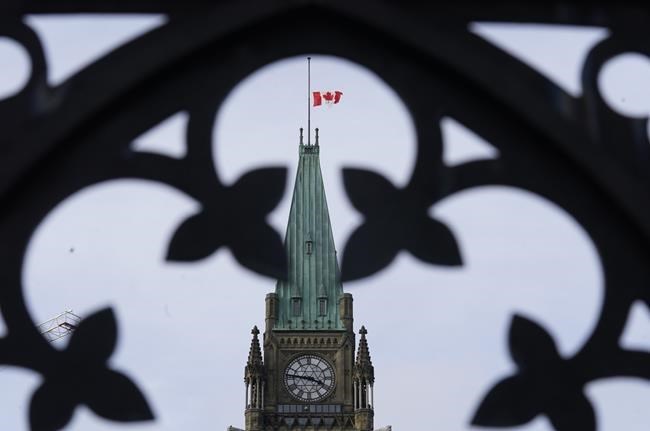OTTAWA — The national chief of the Assembly of First Nations says there needs to be another symbolic gesture made to recognize the genocide of Indigenous children if Canada wants to raise its flag.
RoseAnne Archibald said ideas for such an expression will be discussed when the organization's executive meets this week, adding national Inuit and Métis leaders must also be involved.
Questions about what to do with the national flag have surfaced in the lead-up to Remembrance Day, an occasion on which it has traditionally been lowered to half-mast as a tribute to soldiers who died while serving Canada.
The flags on the Peace Tower at Parliament Hill and other federal buildings have been flying at half-mast since late May, but The Royal Canadian Legion said it plans to raise the flag at Ottawa's National War Memorial on Nov. 11 before immediately lowering it to half-mast again.
Prime Minister Justin Trudeau requested the lowering of the national flags after the Tk'emlups te Secwepemc nation announced ground-penetrating radar detected what are believed to be the remains of 215 Indigenous children at a former residential school in Kamloops, B.C.
Weeks later, the Cowessess First Nation near Regina revealed it found 751 unmarked graves, prompting Indigenous leaders and many non-Indigenous Canadians to redouble their calls for Ottawa to help deliver justice for residential-school survivors.
"You cannot just raise the flags and replace it with nothing," Archibald told The Canadian Press in an interview Saturday.
"That, to me, is a great dishonour and would be a great dishonour and would be hurtful to all of the children we have yet to find."
Archibald said "a symbolic gesture must be found if the flags are going to be raised."
Such action would need to be meaningful, said Archibald, adding AFN believes some kind of symbol needs to stay in place over the long term because there are many former residential-school sites that have yet to be searched for unmarked graves.
It is estimated more 4,000 Indigenous children died while being forced to attend the church-run, government-funded institutions, where thousands more suffered physical and sexual abuse, neglect, and malnutrition.
The 2015 report from Canada's the Truth and Reconciliation Commission, which was based on testimony from thousands of former students, said the system that operated for more than 120 years perpetuated a "cultural genocide" against survivors.
Archibald said there's well over 130 of these institutions of "assimilation and genocide" left to investigate.
"We have a long road," she said.
"These children deserve to be found, named, and buried with proper ceremony and returned, either physically or ceremonially, to their homelands. This is a very important thing for us as First Nations people."
As for Nov. 11, it is up to Trudeau if he wants to lift the flag.
The Royal Canadian Legion has indicated it would raise the flag at the National War Memorial on Remembrance Day morning before lowering it again during a scheduled ceremony to honour the dead. The flag will then be presented to this year's Silver Cross mother, who represents mothers of the soldiers who died in military service.
The legion has recommended branches across Canada hoist the flag before their individual ceremonies, but a spokeswoman said the decision to do so is up to them.
The legion has the power to control what happens to the flag at the National War Memorial that day because it is in charge of the annual ceremony at the site.
After Nov. 11, it's again up to the government to decide at what height the flag flies at the memorial.
Canadian Heritage said flags at government buildings and the Peace Tower remain lowered in memory of Indigenous children who died attending residential schools, as well as survivors and their families.
The department said on Friday that unless the prime minister decides to return the flag to full mast before Remembrance Day, it will remain at half-mast on that day instead of being hoisted up and lowered to half-mast again.
Trudeau has previously said he would keep the national flag lowered at federal sites until Indigenous Peoples are ready to see it raised.
Conservatives feel differently. Opposition Leader Erin O'Toole, who served in the air force, said it's time to hoist the flag because there are many reasons to be proud of Canada, and raising the national symbol should be seen as a sign the country commits itself to build a better future.
This report by The Canadian Press was first published Oct. 31, 2021
Stephanie Taylor, The Canadian Press



